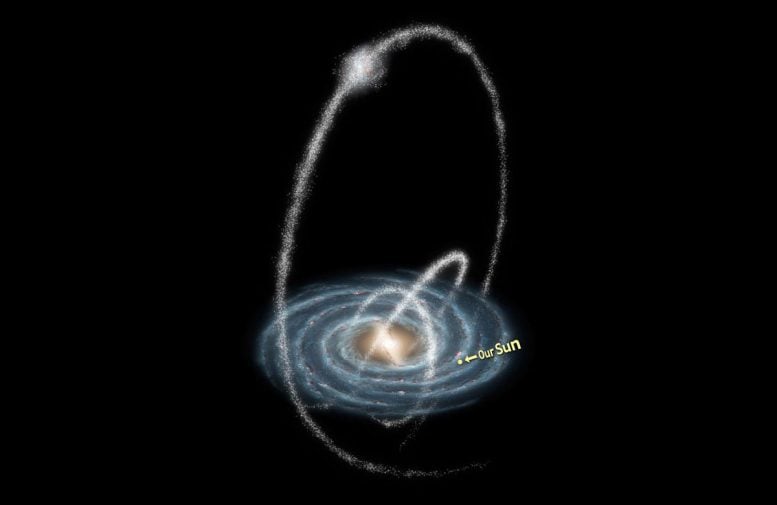
An artistic rendering of generic stellar streams in the Milky Way. Credit: NASA/JPL-Caltech/R. Hurt, SSC & Caltech
Examination of Theia 456 finds its nearly 500 stars were born at same time.
The Milky Way houses 8,292 recently discovered stellar streams — all named Theia. But Theia 456 is special.
A stellar stream is a rare linear pattern — rather than a cluster — of stars. After combining multiple datasets captured by the Gaia space telescope, a team of astrophysicists found that all of Theia 456’s 468 stars were born at the same time and are traveling in the same direction across the sky.
“Most stellar clusters are formed together,” said Jeff Andrews, a Northwestern University astrophysicist and member of the team. “What’s exciting about Theia 456 is that it’s not a small clump of stars together. It’s long and stretched out. There are relatively few streams that are nearby, young and so widely dispersed.”
Andrews presented this research during a virtual press briefing at the 237th meeting of the American Astronomical Society. “Theia 456: A New Stellar Association in the Galactic Disk” took place on January 15, 2021, as a part of a session on “The Modern Milky Way.”
Andrews is a postdoctoral fellow at Northwestern’s Center for Interdisciplinary Exploration and Research in Astrophysics (CIERA). He conducted this work with astrophysicists Marcel Agüeros and Jason Curtis of Columbia University, Julio Chanamé of Pontifica Universidad Catolica, Simon Schuler of University of Tampa and Kevin Covey and Marina Kounkel of Western Washington University.
While researchers have long known that stars form in groups, most known clusters are spherical in shape. Only recently have astrophysicists started to find new patterns in the sky. They believe long strings of stars were once tight clusters, gradually ripped apart and stretched by tidal forces.
“As we’ve started to become more advanced in our instrumentation, our technology and our ability to mine data, we’ve found that stars exist in more structures than clumps,” Andrews said. “They often form these streams across the sky. Although we’ve known about these for decades, we’re starting to find hidden ones.”
Stretching more than 500 light-years, Theia 456 is one of those hidden streams. Because it dwells within the Milky Way’s galactic plane, it’s easily lost within the galaxy’s backdrop of 400 billion stars. Most stellar streams are found elsewhere in the universe — by telescopes pointed away from the Milky Way.
“We tend to focus our telescopes in other directions because it’s easier to find things,” Andrews said. “Now we’re starting to find these streams in the galaxy itself. It’s like finding a needle in a haystack. Or, in this case, finding a ripple in an ocean.”
Identifying and examining these structures is a data science challenge. Artificial intelligence algorithms combed huge datasets of stellar data in order to find these structures. Then Andrews developed algorithms to cross-reference those data with pre-existing catalogs of documented stars’ iron abundances.
Andrews and his team found that the 468 stars within Theia 456 had similar iron abundances, which means that — 100 million years ago — the stars likely formed together. Adding further evidence to this finding, the researchers examined a light curves dataset, which captures how stars’ brightness changes over time.
“We’re starting to find these streams in the Milky Way galaxy itself. It’s like finding a needle in a haystack. Or, in this case, finding a ripple in an ocean” — Jeff Andrews, astrophysicist
“This can be used to measure how fast the stars are spinning,” Agüeros said. “Stars with the same age should show a distinct pattern in their spin rates.”
With the help of data from NASA’s Transiting Exoplanet Survey Satellite and from the Zwicky Transient Facility — both of which produced light curves for stars in Theia 456 — Andrews and his colleagues were able to determine that the stars in the stream do share a common age.
The team also found that the stars are moving together in the same direction.
“If you know how the stars are moving, then you can backtrack to find where the stars came from,” Andrews said. “As we rolled the clock backward, the stars became closer and closer together. So, we think all these stars were born together and have a common origin.”
Andrews said combining datasets and data mining is essential to understanding the universe around us.
“You can only get so far with one dataset,” he said. “When you combine datasets, you get a much richer sense of what’s out there in the sky.”

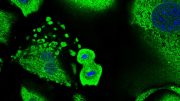
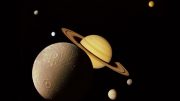

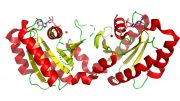
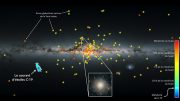
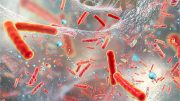
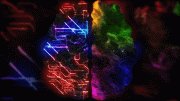
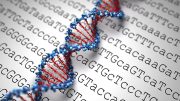
What direction is our sun going exactly and where will we end up?
Nice job on the story though without sarcasm I enjoyed this news.
Where should I even begin to show you truth of existing facts . Our Little glitch of an idea of a galaxy . Is exactly how I wrote it .You have not even seen the rim of the Milky Way . The further you travel in space . Illusions , lights that are not there . .There is an Black Hole that could swallow The And Earth 2 trillion 873 billion 602 million 456 thousand 182 square miles in size . It’s there trust me . It will be another 24.357 years from now before you will see the outer perimeter of your Milky Way !
I had to snicker just a bit as the streams of stars were described as having been in clusters, but torn apart by “…tidal forces…”. Tough situation, by golly, when the tide goes out, it just rips those stars all to pieces…!
Q look at the galaxy your universe & ask are you been pulled in or are you been thrown out.
You may try asking yourself, on which side of the event horizon are you standing
Ok great story. So let’s talk about our galaxie and what we know so we know that a blacksphere lies at the center and we know that it creates a magnetic bubble that surrounds and protects our galaxie. We also know that the blacksphere is an incubator for star birth. So is the bubble providing the pressure need to force stars into fusing the gases? The same goes for our star and solar system the sun provides the bubble and the pressure to create planets. Now we’re getting somewhere. So do we know if stars form outside of galaxies if I was to guess I would say no they don’t. So let’s go back in time to when the stars that created the blacksphere in the center of our galaxie were present what created the pressure to create those stars? My only conclusion thus far is all the galaxies we can see weren’t always galaxies at one point they were simply really big stars before they went supernova. So before the galaxies there had to of been less really big stars but would have had the same mass as its galaxie. So my theory is that every galaxy had one star in the beginning that’s now the blacksphere in the center. Yes there has been mergers but each started from a single star. I’m wondering how many stars right now are made of the same stuff in different galaxies? If I had that info I could tell you how many early stars their was in our observable universe. Also it might give hints to how big the star was that gave birth to the observable part of the universe. Question whats the purest form of hydrogen what state is it in? So what I’m wondering is we must be circling some type of sphere not our galaxie all the galaxies everything we can see is circling a sphere are we in an arm of a sphere everything I’ve read watched listened to leads me to this conclusion. Yes we are circling a really big sphere and were in an arm of that sphere. The sun created planets and cleared all the matter into circles moving in a circular motion around our sun that’s circling a blacksphere that’s circular moving in a circular motion with other galaxies that are moving in a circular motion that are circling the original blacksphere that created the galaxies that have cleared the matter around them into galaxies. We’re moving around something everything we can see is moving around something else so the real question is what are all the galaxies moving around. I know the guy on TV said were not moving around a blacksphere but I believe he is mistaken that’s exactly what we’re doing I believe that’s the answer to the question we are moving around some type of hypersphere that is our universe.